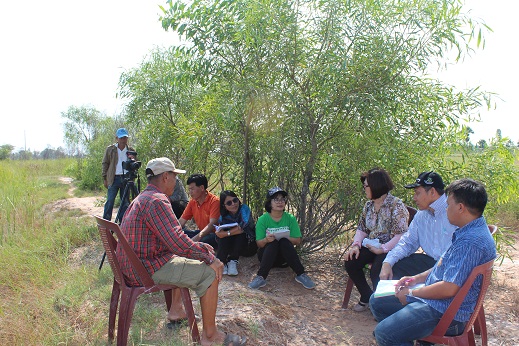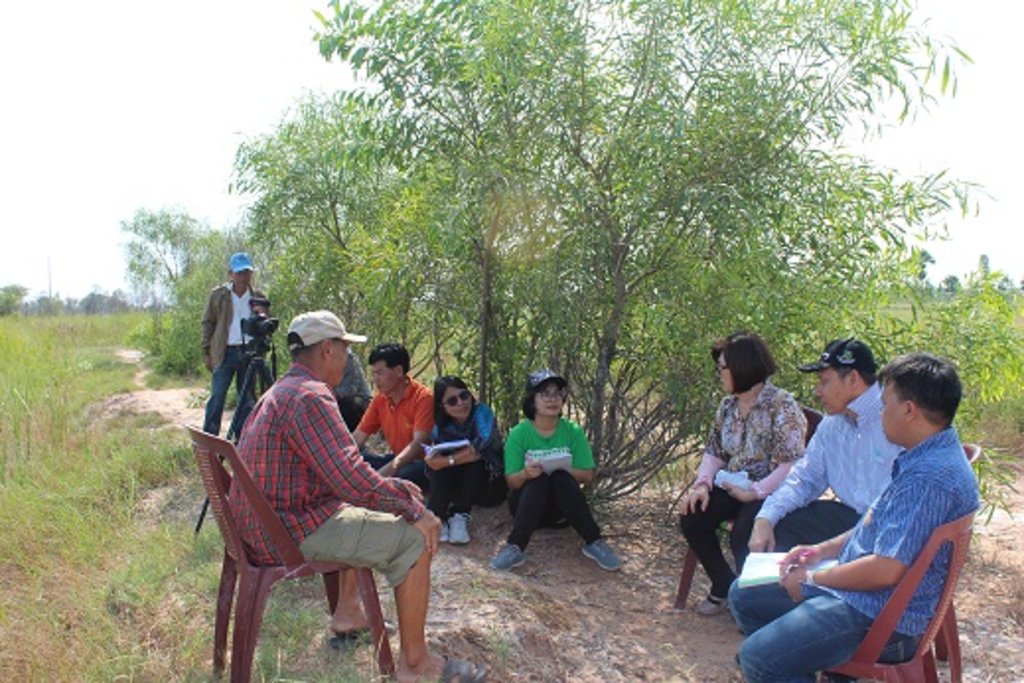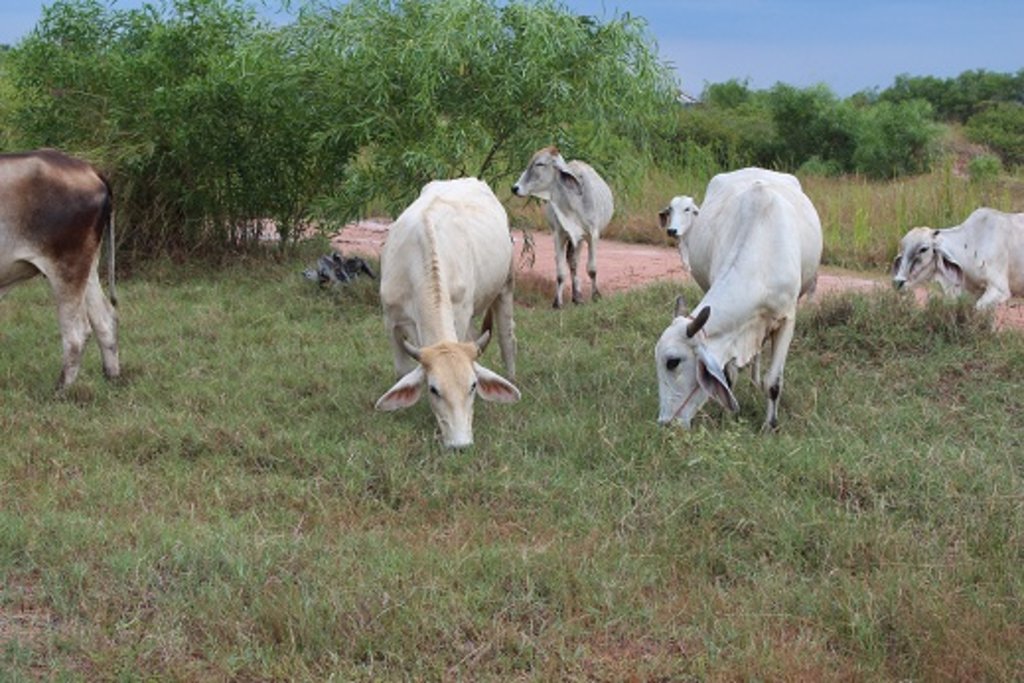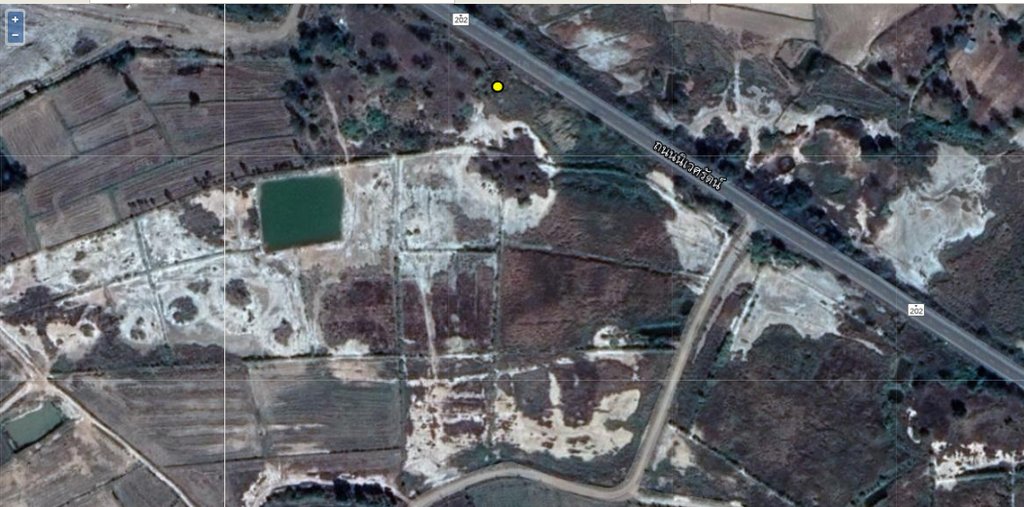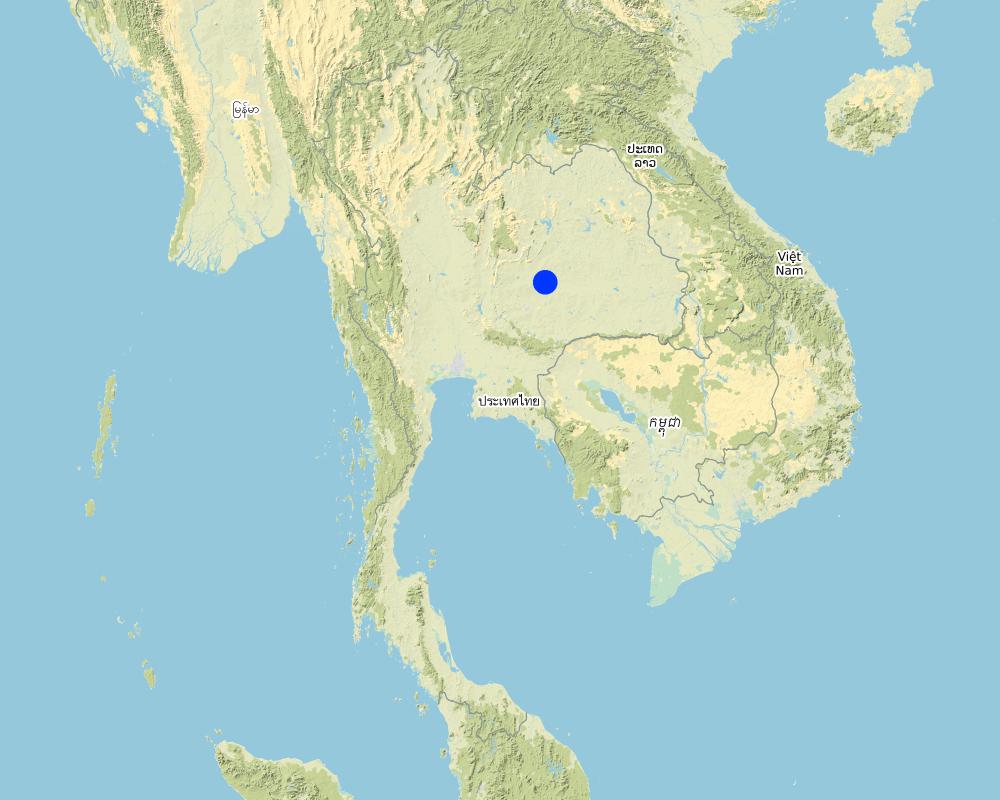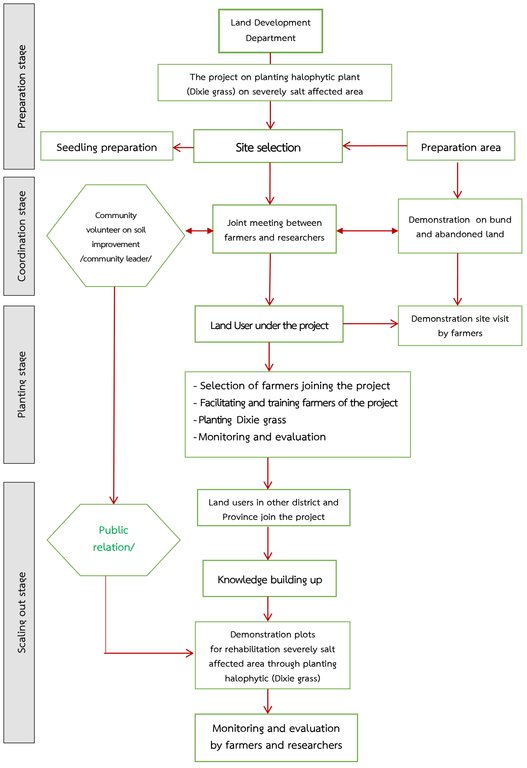Vegetative approach of using a halophyte ("Dixie grass", Sporobolus virginicus)) to rehabilitate severely salt-affected land. [ប្រទេសថៃ]
- ការបង្កើត៖
- បច្ចុប្បន្នភាព
- អ្នកចងក្រង៖ Kamontip Sasithorn
- អ្នកកែសម្រួល៖ –
- អ្នកត្រួតពិនិត្យច្រើនទៀត៖ Rima Mekdaschi Studer, Samran Sombatpanit, William Critchley
approaches_4210 - ប្រទេសថៃ
ពិនិត្យមើលគ្រប់ផ្នែក
ពង្រីកមើលទាំងអស់ បង្រួមទាំងអស់1. ព័ត៌មានទូទៅ
1.2 ព័ត៌មានលម្អិតពីបុគ្គលសំខាន់ៗ និងស្ថាប័នដែលចូលរួមក្នុងការវាយតម្លៃ និងចងក្រងឯកសារនៃវិធីសាស្ត្រផ្សព្វផ្សាយ
បុគ្គលសំខាន់ម្នាក់ (ច្រើននាក់)
អ្នកប្រើប្រាស់ដី:
Yooburi Somsak
+66-80-7240599
10 Moo 12, Ban Kut Chok, Kut Chok Sub-district, Buayai District, Nakhon Ratchasima Province 30120
ប្រទេសថៃ
អ្នកប្រើប្រាស់ដី:
Sriwootpong Rungariam
+66-93-4613289
107 Ban Donpae Moo 8, Kut Chok Sub-district, Buayai District, Nakhon Ratchasima Province
ប្រទេសថៃ
Department of Agricultural Extension officer:
Auonpokang Chiwat
+66-85-7783258
Buayai District Agricultural Extension Office
49 Buayai Sub-district, Buayai District, Nakhon Ratchasima Province 30120
ប្រទេសថៃ
អ្នកប្រើប្រាស់ដី:
Kumtisong Noorian
+66-62-1524591
45 Moo 10, Dang-chang Sub-district, Buayai District, Nakhon Ratchasima Province 30120
ប្រទេសថៃ
អ្នកជំនាញឯកទេស SLM:
អ្នកជំនាញឯកទេស SLM:
អ្នកជំនាញឯកទេស SLM:
អ្នកជំនាញឯកទេស SLM:
National consultant:
ឈ្មោះគម្រោងដែលបានចងក្រងឯកសារ/ វាយតម្លៃលើវិធីសាស្ត្រផ្សព្វផ្សាយ (បើទាក់ទង)
Book project: where the land is greener - Case Studies and Analysis of Soil and Water Conservation Initiatives Worldwide (where the land is greener)ឈ្មោះគម្រោងដែលបានចងក្រងឯកសារ/ វាយតម្លៃលើវិធីសាស្ត្រផ្សព្វផ្សាយ (បើទាក់ទង)
Book project: where the land is greener - Case Studies and Analysis of Soil and Water Conservation Initiatives Worldwide (where the land is greener)ឈ្មោះអង្គភាពមួយ (ច្រើន) ដែលបានចងក្រងឯកសារ/ វាយតម្លៃលើវិធីសាស្ត្រផ្សព្វផ្សាយ (បើទាក់ទង)
Land Development Department LDD (Land Development Department LDD) - ប្រទេសថៃ1.3 លក្ខខណ្ឌទាក់ទងទៅនឹងការប្រើប្រាស់ទិន្នន័យដែលបានចងក្រងតាមរយៈវ៉ូខេត
តើពេលណាដែលទិន្នន័យបានចងក្រង (នៅទីវាល)?
18/10/2018
អ្នកចងក្រង និង(បុគ្គលសំខាន់ៗ)យល់ព្រមទទួលយកនូវលក្ខខណ្ឌនានាទាក់ទងទៅនឹងការប្រើប្រាស់ទិន្នន័យដែលបានចងក្រងតាមរយៈ វ៉ូខេត:
បាទ/ចា៎
1.4 ការយោងមួយ (ច្រើន) ទៅលើ (កម្រង) បញ្ជីសំណួរនៃបច្ចេកទេស SLM
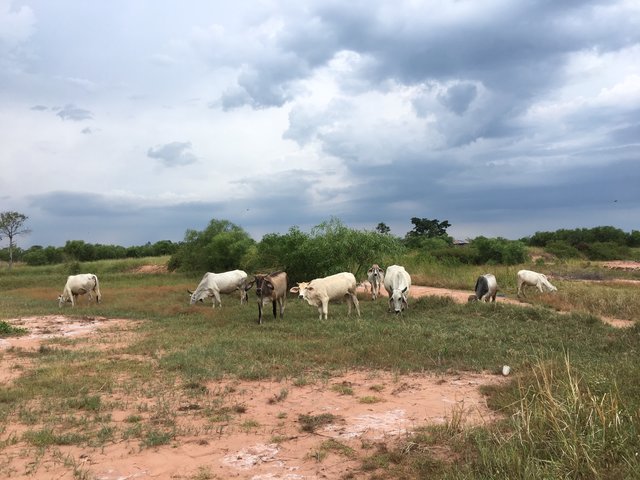
Planting a Halophyte (Sporobolus virginicus, "Dixie grass") to … [ប្រទេសថៃ]
Planting a halophyte - Dixie grass (Sporobolus verginicus) - aims to increase the area of land usable by farmers and to prevent expansion of severely saline soils. Dixie grass can be utilised as cattle feed. The Land Development Department has been involved in developing and disseminating this technology.
- អ្នកចងក្រង៖ Kamontip Sasithorn
2. ការពណ៌នាអំពីវិធីសាស្ត្រផ្សព្វផ្សាយ SLM
2.1 ពណ៌នាសង្ខេបខ្លីពីវិធីសាស្ត្រផ្សព្វផ្សាយ
The government promotes a halophyte (Dixie grass) to control severely salt-affected land, rehabilitate the ecosystem and prevent the spread of salt in soil - with the cooperation of land owners, livestock farmers, the local administration, the local government agency, Land Development Department researchers and with specialists/ technical advisors in various fields.
2.2 ពណ៌នាលម្អិតពិវិធីសាស្ត្រផ្សព្វផ្សាយ
ពណ៌នាលម្អិតពិវិធីសាស្ត្រផ្សព្វផ្សាយ:
The Ministry of Agriculture and Cooperatives through its Land Development Department (LDD) initiated a project on planting salt-tolerant trees and grasses on severely salt-affected land in the Northeast of Thailand in 1996. The project has facilitated the planting of a halophyte (a salt-loving plant), namely Sporobulus virginicus (Dixie grass) on salt-crusted and barren land. The main objectives of the approach has been to encourage land users to maximize their land area for farming, by preventing the formation of extensive severely saline soil. This is through planting Dixie grass as a cover crop to rehabilitate the land and ecosystem. The activities started with public meetings, then identifying severely salt-affected areas, and setting-up demonstration plots on farmers’ land to act as learning centers. There has also been communication with the local administration to call farmers’ meetings to develop detailed work plans and discuss strengths, weaknesses, opportunities, and threats of planting Dixie grass. The implementing activities consisted of 4 stages; PREPARATION was for seedling preparation, site selection of severely salt-affected soil and land preparation, public meetings and the establishment of the demonstration plot at Dan Chang Sub-district, Buayai District, Nakhon Ratchasima Province. COORDINATION included a joint meeting between farmers and researchers, joint monitoring & evaluation and follow-up and land users' decision-making. PLANTING started with selection of farmers joining the project, facilitating and training, a site visit to the model demonstration plot: this plot is the model for planting salt-tolerant trees and grasses on severely salt-affected land in the Northeast of Thailand. The final activity of SCALING-OUT occured when the land users/ farmers found that after 3 years of planting Dixie grass this barren land became covered by plants and much improved in biodiversity by the evidence of many varieties of wild grasses, flowers, dragonflies, small mammals and birds. Farmers could now grow rice and they used Dixie grass as feed for livestock. Moreover, and attractively, farmers were able to increase their incomes. Migration to big cities was reduced. The stakeholders were land owners, livestock farmers, the local administration, the local government agency, researchers and SLM specialists from LDD - and all worked together to mutual benefit. Nevertheless, although planting halophytes improves severely saline soil with low input costs, the recovery/accomplishment time (in saline soil improvement) cannot be as fast as that of engineering measures with much higher investment.
2.3 រូបភាពនៃវិធីសាស្ត្រផ្សព្វផ្សាយ
2.4 វីឌីអូនៃវិធីសាស្ត្រផ្សព្វផ្សាយ
កាលបរិច្ឆេទ:
18/10/2018
ទីតាំង:
6 Ban Donpae Moo 8, Kut Chok Sub-district, Buayai District, Nakhon Ratchasima Province
2.5 ប្រទេស/តំបន់/ទីតាំងកន្លែង ដែលវិធីសាស្ត្រផ្សព្វផ្សាយត្រូវបានអនុវត្តន៍
ប្រទេស:
ប្រទេសថៃ
តំបន់/រដ្ឋ/ខេត្ត:
Nakhon Ratchasima Province
បញ្ជាក់បន្ថែមពីលក្ខណៈនៃទីតាំង:
6 Ban Donpae Moo 8, Kut Chok Sub-district, Buayai District
Map
×2.6 កាលបរិច្ឆេទនៃការចាប់ផ្តើម និងបញ្ចប់នៃវិធីសាស្រ្តផ្សព្វផ្សាយនេះ
សូមបញ្ជាក់ឆ្នាំដែលបានបង្កើតឡើង:
2015
ឆ្នាំបញ្ចប់ (ប្រសិនបើវិធីសាស្ត្រផ្សព្វផ្សាយត្រូវបានឈប់ប្រើប្រាស់):
2016
2.7 ប្រភេទនៃវិធីសាស្ត្រផ្សព្វផ្សាយ
- ផ្អែកលើគម្រោង/កម្មវិធី
2.8 គោលបំណង/ទិសដៅសំខាន់នៃវិធីសាស្ត្រផ្សព្វផ្សាយ
The main objective of the approach was to enable and encourage land users to maximize land for farming, through preventing the formation of extensive severely saline soil, by the use of the halophyte, Dixie grass, as a cover crop.
2.9 លក្ខខណ្ឌអនុញ្ញាត ឬរារាំងការអនុវត្តន៍បច្ចេកទេសដែលស្ថិតនៅក្រោមវិធីសាស្រ្តផ្សព្វផ្សាយ
សង្គម/វប្បធម៌/ និងតម្លៃនៃសាសនា
- អំណោយផល
The land users follow what their neighbours practice.
ភាពអាចរកបាននៃធនធានហិរញ្ញវត្ថុ និងសេវាកម្ម
- អំណោយផល
Through the Bank for Agriculture and Agricultural Cooperatives.
បរិបទនៃស្ថាប័ន
- អំណោយផល
Local administration
ការសហការ/ការសម្របសម្រួលតួអង្គពាក់ព័ន្ធ
- អំណោយផល
Coordination of soil doctor volunteers and community leaders in the area.
គោលនយោបាយ
- អំណោយផល
The government has a policy of preventing soil degradation.
ចំណេះដឹងស្តីពី SLM និងការទទួលបានការគាំទ្រផ្នែកបច្ចេកទេស
- អំណោយផល
To provide knowledge to land users in the area.
ទំហំការងារ ភាពអាចរកបាននៃកម្លាំងពលកម្ម
- អំណោយផល
For land users under the project
- រារាំង
For land users outside the project
3. ការចូលរួម និងតួនាទីរបស់ភាគីពាក់ព័ន្ធ
3.1 អ្នកពាក់ព័ន្ធដែលបានចូលរួមក្នុងវិធីសាស្ត្រផ្សព្វផ្សាយ និងតួនាទីរបស់ពួកគេ
- អ្នកប្រើប្រាស់ដីក្នុងតំបន់/សហគមន៍
Farmers under the project
Planting halophytes (Sporobolus virginicus - Dixie grass)
- អង្គការសហគមន៍មូលដ្ឋាន
Local administration (Sub-district Administration Organization)
Call for meeting
- អ្នកឯកទេសគ្រប់គ្រងដីប្រកបដោយចីរភាព/ទីប្រឹក្សាបច្ចេកទេសកសិកម្ម
Land Development Department
Site selection
- អ្នកស្រាវជ្រាវ
Land Development Department
Provide technical recommendations
- រដ្ឋាភិបាលថ្នាក់ជាតិ (អ្នករៀបចំផែនការ អ្នកសម្រេចចិត្ត)
Land Development Department
Funding, planner, decision-makers
3.2 ការចូលរួមរបស់អ្នកប្រើប្រាស់ដីក្នុងតំបន់/ សហគមន៍ក្នុងតំបន់ក្នុងដំណាក់កាលផ្សេងគ្នានៃវិធីសាស្រ្តផ្សព្វផ្សាយ
| ការចូលរួមរបស់អ្នកប្រើប្រាស់ដីក្នុងតំបន់/សហគមន៍ក្នុងតំបន់ | សូមបញ្ជាក់នរណាត្រូវបានចូលរួម ព្រមទាំងពណ៌នាសកម្មភាពទាំងនោះ | |
|---|---|---|
| ការចាប់ផ្តើម/ការលើកទឹកចិត្ត | អន្តរកម្ម | Land users in the project based |
| ការរៀបចំផែនការ | អសកម្ម | Discussion with land users on work plan before starting the activity. |
| ការអនុវត្តន៍ | ការគាំទ្រពីខាងក្រៅ | Land users/farmers in the project |
| ការត្រួតពិនិត្យ និងវាយតម្លៃ | ការគាំទ្រពីខាងក្រៅ | Land users in the project |
3.3 គំនូសបំព្រួញ (ប្រសិនបើមាន)
ការពណ៌នា:
Four stages of participating process of technology development among organizations, community volunteers on soil improvement, farmers, SLM specialists and researchers.
អ្នកនិពន្ធ:
Kamontip Sasithorn
3.4 ការសម្រេចចិត្តលើការជ្រើសរើសបច្ចេកទេស SLM
សូមបញ្ជាក់តើអ្នកណាជាអ្នកបានសម្រេចចិត្តក្នុងការជ្រើសរើសបច្ចេកទេសដើម្បីយកមកអនុវត្តន៍:
- អ្នកជំនាញឯកទេស SLM បន្ទាប់ពីបានប្រឹក្សាយោបល់ជាមួយអ្នកប្រើប្រាស់ដី
សូមបញ្ជាក់ តើការសម្រេចធ្វើឡើងដោយផ្អែកលើអ្វីជាមូលដ្ឋាន:
- វាយតម្លៃទៅលើចំណេះដឹងស្តីអំពី SLM ដែលបានចងក្រងជាឯកសារបានត្រឹមត្រូវ (ផ្អែកលើភស្តុតាងជាមូលដ្ឋានដើម្បីសម្រេចចិត្ត)
4. ជំនួយបច្ចេកទេស ការកសាងសមត្ថភាព និងការគ្រប់គ្រងចំណេះដឹង
4.1 ការកសាងសមត្ថភាព/ បណ្តុះបណ្តាល
តើវគ្គបណ្តុះបណ្តាលបានផ្តល់ឱ្យអ្នកប្រើប្រាស់ដី/អ្នកពាក់ព័ន្ធផ្សេងៗទៀតដែរឬទេ?
បាទ/ចា៎
សូមបញ្ជាក់តើអ្នកណាត្រូវបានបណ្តុះបណ្តាល:
- អ្នកប្រើប្រាស់ដី
ទម្រង់នៃការបណ្តុះបណ្តាល:
- ទីតាំងបង្ហាញ
- ការប្រជុំជាសាធារណៈ
ប្រធានបទបណ្តុះបណ្តាល:
Prevention and rehabilitation of salt-affected land with available technology and increased income for farmers.
4.2 សេវាផ្តល់ប្រឹក្សាយោបល់
តើអ្នកប្រើប្រាស់ដីបានទទួលនូវសេវាផ្តល់ប្រឹក្សាដែរ ឬទេ?
បាទ/ចា៎
សូមបញ្ជាក់ប្រសិនបើសេវាកម្មប្រឹក្សាយោបល់ត្រូវបានផ្តល់ឱ្យ:
- នៅលើដីរបស់អ្នកប្រើប្រាស់ដី
ពណ៌នា/ពន្យល់:
1. Soil doctor volunteers represent the Land Development Department with a duty to provide knowledge to farmers in the area.
2. SLM specialists from Land Development Department visited and advised farmers in the area.
4.3 ការពង្រឹងសមត្ថភាពស្ថាប័ន (ការអភិរឌ្ឍន៍អង្គភាព)
តើស្ថាប័នទាំងអស់ត្រូវបានបង្កើតឡើង ឬពង្រឹងសមត្ថភាពតាមរយៈវិធីសាស្ត្រផ្សព្វផ្សាយដែរ ឬទេ?
- ទេ
4.4 ការត្រួតពិនិត្យ និងវាយតម្លៃ
តើការត្រួតពិនិត្យ និងវាយតម្លៃគឺជាផ្នែកមួយនៃវិធីសាស្ត្រដែរឬទេ?
បាទ/ចា៎
មតិយោបល់:
SLM specialists from Land Development Department collaborated with LDD soil doctor volunteers in surveying the survival rate and following up the growth of plants in the area.
ប្រសិន បាទ/ច៎ា តើឯកសារនេះបានបង្កើតឡើងក្នុងគោលបំណងប្រើប្រាស់សម្រាប់ការត្រួតពិនិត្យ និងវាយតម្លៃដែរឬទេ?
បាទ/ចា៎
4.5 ការស្រាវជ្រាវ
តើការស្រាវជ្រាវ គឺជាផ្នែកមួយនៃវិធីសាស្រ្តដែរឬទេ?
បាទ/ចា៎
បញ្ជាក់ប្រធានបទ:
- បច្ចេកវិទ្យា
សូមផ្តល់ព័ត៌មានបន្ថែមទៀតឱ្យបានលម្អិត និងចង្អុលបង្ហាញនរណាដែលបានធ្វើការស្រាវជ្រាវ:
The Soil Salinity Research Group, LDD, conducted research on "halophytes plantation and the flow path along the landscape in Northeast Thailand" with Dr. J.L. Gallagher from Delaware Biotechnology Institute, University of Delaware.
5. ថវិកា និងសម្ភារៈឧបត្ថម្ភពីខាងក្រៅ
5.1 ថវិកាប្រចាំឆ្នាំសម្រាប់ផ្សព្វផ្សាយ SLM
ប្រសិនបើចំនួនពិតប្រាកដនៃថវិកាប្រចាំឆ្នាំមិនត្រូវបានដឹងច្បាស់ សូមប្រាប់ពីចន្លោះនៃថវិកានោះ:
- < 2,000
មតិយោបល់ (ឧ. ប្រភពសំខាន់នៃមូលនិធិ/ម្ចាស់ជំនួយចំបង):
Land Development Department
5.2 ការគាំទ្រផ្នែកហិរញ្ញវត្ថុ / សម្ភារៈដែលបានផ្តល់ទៅឱ្យអ្នកប្រើប្រាស់ដី
តើអ្នកប្រើប្រាស់ដីបានទទួលការគាំទ្រផ្នែកហិរញ្ញវត្ថ/សម្ភារៈសម្រាប់ការអនុវត្តន៍បច្ចេកទេសដែរឬទេ:
បាទ/ចា៎
ប្រសិនបាទ/ច៎ា សូមបញ្ជាក់ប្រភេទ(ច្រើន)នៃការគាំទ្រ លក្ខខណ្ឌ និងអ្នកផ្តល់ឱ្យ(ច្រើន):
Dixie grass planting material and land preparation cost
5.3 សូមបញ្ជាក់ពីធាតុចូលត្រូវបានផ្តល់បដិភាគ (រួមទាំងកម្លាំងពលកម្ម)
- កម្លាំងពលកម្ម
| កម្រិតទំហំប៉ុណ្ណា | សូមបញ្ជាក់ពីការបដិភាគ |
|---|---|
| ផ្តល់ហិរញ្ញវត្ថុទាំងស្រុង | Planting |
- ផ្សេងៗ
| ផ្សេងៗ (បញ្ចាក់) | កម្រិតទំហំប៉ុណ្ណា | សូមបញ្ជាក់ពីការបដិភាគ |
|---|---|---|
| seeding | ផ្តល់ហិរញ្ញវត្ថុទាំងស្រុង | free seedings |
ប្រសិនបើកម្លាំងពលកម្មធ្វើដោយអ្នកប្រើប្រាស់ដី តើវាជាធាតុចូលដ៏សំខាន់មួយដែរ ឬទេ:
- បង់ជាសាច់ប្រាក់
មតិយោបល់:
Due to the landowner having insufficient labor for grass planting, there is a need to hire workers at 175 THB/person/day (the minimum rate)
5.4 ឥណទាន
តើឥណទានដែលបានផ្តល់នៅក្រោមវិធីសាស្ត្រផ្សព្វផ្សាយសម្រាប់សកម្មភាព SLM នេះយ៉ាងដូចម្តេច?
ទេ
5.5 ការលើកទឹកចិត្ត ឬវិធីសាស្ត្រដ៏ទៃទៀត
តើមានការលើកទឹកចិត្តផ្សេងទៀត ឬឧបករណ៍ប្រើប្រាស់ដើម្បីលើកកម្ពស់ការអនុវត្តន៍បច្ចេកទេស SLM?
ទេ
6. ការវិភាគរកផលប៉ះពាល់ និងសេចក្តីសន្និដ្ឋាន
6.1 ផលប៉ះពាល់នៃវិធីសាស្ត្រផ្សព្វផ្សាយ
តើវិធីសាស្ត្រផ្សព្វផ្សាយបានផ្តល់សិទ្ធិអំណាចដល់អ្នកប្រើប្រាស់ដី ធ្វើឱ្យប្រសើរឡើងនូវការចួលរួមអ្នកពាក់ព័ន្ធ?
- ទេ
- បាទ/ច៎ា បន្តិចបន្តួច
- បាទ/ច៎ា ជាមធ្យម
- បាទ/ច៎ា បានខ្លាំង
Generate food security and family income.
តើវិធីសាស្រ្តផ្សព្វផ្សាយនេះអនុញ្ញាតឱ្យធ្វើការសម្រេចចិត្ដដោយផ្អែកលើភស្តុតាងជាមូលដ្ឋានដែរ ឬទេ?
- ទេ
- បាទ/ច៎ា បន្តិចបន្តួច
- បាទ/ច៎ា ជាមធ្យម
- បាទ/ច៎ា បានខ្លាំង
Establish learning center for farmers as an information for technology adoption.
តើវិធីសាស្ត្រផ្សព្វផ្សាយជួយអ្នកប្រើប្រាស់ដីដើម្បីអនុវត្តន៍ និងថែទាំបច្ចេកទេស SLM?
- ទេ
- បាទ/ច៎ា បន្តិចបន្តួច
- បាទ/ច៎ា ជាមធ្យម
- បាទ/ច៎ា បានខ្លាំង
Farmers well adopted the technology, resulting in the expansion of such Approach to a wider area.
តើវិធីសាស្ត្រផ្សព្វផ្សាយនេះធ្វើឱ្យចំណេះដឹងប្រសើឡើង និងសមត្ថភាពរបស់អ្នកប្រើប្រាស់ដីក្នុងការអនុវត្តន៏ SLM?
- ទេ
- បាទ/ច៎ា បន្តិចបន្តួច
- បាទ/ច៎ា ជាមធ្យម
- បាទ/ច៎ា បានខ្លាំង
Farmers have adapted and changed SLM model to suit their own preference.
តើវិធីសាស្ត្រផ្សព្វផ្សាយនាំឱ្យប្រសើរឡើងនូវសន្តិសុខស្បៀង/ធ្វើឱ្យប្រសើរឡើងនូវអាហាររូបត្ថម្ភ?
- ទេ
- បាទ/ច៎ា បន្តិចបន្តួច
- បាទ/ច៎ា ជាមធ្យម
- បាទ/ច៎ា បានខ្លាំង
Farmers can grow rice and they use Dixie grass as feed for livestock.
តើវិធីសាស្ត្រផ្សព្វផ្សាយនេះនាំឱ្យមានការងារ ឱកាសរកប្រាក់ចំណូល?
- ទេ
- បាទ/ច៎ា បន្តិចបន្តួច
- បាទ/ច៎ា ជាមធ្យម
- បាទ/ច៎ា បានខ្លាំង
The migration for job to big cities has reduced.
6.2 ការលើកទឹកចិត្តចម្បងៗរបស់អ្នកប្រើប្រាស់ដីសម្រាប់ការអនុវត្តបច្ចេកទេស SLM
- បង្កើនផលិតកម្ម
From the interview, farmers were satisfied with this technology of Sporobolus virginicus planting to rehabilitate severely saline soil. Besides being lower in salination farmers got more rice yields and better environment and livelihoods.
- ការកាត់បន្ថយការធ្លាក់ចុះគុណភាពដី
After 3 years of planting Dixie grass, it was found that the formerly barren land became covered by plants and much improved in biodiversity by the evidence of many varieties of wild grass, dragonflies, small mammals and birds.
6.3 សកម្មភាពផ្សព្វផ្សាយដែលប្រកបដោយចីរភាព
តើអ្នកប្រើប្រាស់ដីអាចធ្វើឱ្យមានចីរភាពនូវអ្វីដែលត្រូវបានអនុវត្តន៍តាមរយៈវិធីសាស្ត្រផ្សព្វផ្សាយដែរឬទេ(ដោយពុំមានការគាំទ្រពីអ្នកខាងក្រៅ)?
- បាទ/ចា៎
ប្រសិនបាទ/ច៎ា សូមរៀបរាប់ថាធ្វើយ៉ាងម៉េច:
Farmers have better understanding and positive attitude of planting halophytes (e.g. Dixie grass). Moreover, they have more income generated from rice yield and livestock, as farmers can now grow rice and used Dixie grass to raise livestock.
6.4 ភាពខ្លាំង/ គុណសម្បត្តិនៃវិធីសាស្ត្រផ្សព្វផ្សាយ
| ភាពខ្លាំង/ គុណសម្បត្តិ/ ឱកាស ទស្សនៈរបស់អ្នកប្រើប្រាស់ដី |
|---|
| Soil doctor volunteer, local government agency and community leader were the coordinators in the area. |
| Farmers had easy access to markets and sources of Dixie grass cuttings. |
| Distribution of Dixie grass cuttings was done at no cost. |
| ភាពខ្លាំង/ គុណសម្បត្តិ/ ឱកាស ទស្សនៈរបស់បុគ្គលសំខាន់ៗ |
|---|
| A supported technique created to make better environment on severely saline soil in the Northeast of Thailand. |
| Technique in planting Dixie grass was provided continually by Land Development Department and community volunteers on soil improvement. |
| A demonstrated plot was established in the area. |
6.5 ភាពខ្សោយ/ គុណវិបត្តិនៃវិធីសាស្ត្រ និងរកដំណោះស្រាយ
| ភាពខ្សោយ/ គុណវិបត្តិ/ ហានិភ័យ ទស្សនៈរបស់អ្នកប្រើប្រាស់ដី | តើបច្ចេកទេសទាំងនោះបានដោះស្រាយបញ្ហាដូចម្តេច? |
|---|---|
| Advertising of project was not extensive enough, particularly to the area of severely saline soil. | It is necessary for the Land Development Department to cooperate more closely with local administration to promote the project. |
| ភាពខ្សោយ/ គុណវិបត្តិ/ ហានិភ័យក្នុងទស្សនៈរបស់បុគ្គលសំខាន់ៗ | តើបច្ចេកទេសទាំងនោះបានដោះស្រាយបញ្ហាដូចម្តេច? |
|---|---|
| Some farmers did not believe that Dixie grass was very salt tolerant and will make the salinity of the soil decrease after planting it. | The officers should build up knowledge from successful farmers by frequently visiting farmers in the area under the project "rehabilitation of severely salt-affected soil by planting Dixie grass". |
7. ឯកសារយោង និងវេបសាយ
7.1 វិធីសាស្ត្រ/ ប្រភពនៃព័ត៌មាន
- ការសម្ភាសន៍ជាមួយអ្នកប្រើប្រាស់ដី
- ការសម្ភាសន៍ជាមួយអ្នកជំនាញ/ ឯកទេស
7.2 ឯកសារយោងដែលបានចេញផ្សាយ
ចំណងជើង អ្នកនិពន្ធ ឆ្នាំ ISBN:
Land Development Department
មានប្រភពមកពីណា? ថ្លៃដើមប៉ុន្មាន?
http://www.ldd.go.th/
7.3 ចូលទៅទាញយកឯកសារពាក់ព័ន្ធដែលមានលើបណ្តាញអ៊ិនធឺណែត
ចំណងជើង/ ពណ៌នា:
where the land is greener - Case Studies and Analysis of Soil and Water Conservation Initiatives Worldwide
វេបសាយ:
https://www.wocat.net/library/media/27/
ចំណងជើង/ ពណ៌នា:
where people and their land are safer - A Compendium of Good Practices in Disaster Risk Reduction (DRR) (where people and their land are safer) URL:
វេបសាយ:
https://www.wocat.net/en/projects-and-countries/projects/drr
ការតភ្ជាប់ និងម៉ូឌុល
ពង្រីកមើលទាំងអស់ បង្រួមទាំងអស់ការតភ្ជាប់

Planting a Halophyte (Sporobolus virginicus, "Dixie grass") to … [ប្រទេសថៃ]
Planting a halophyte - Dixie grass (Sporobolus verginicus) - aims to increase the area of land usable by farmers and to prevent expansion of severely saline soils. Dixie grass can be utilised as cattle feed. The Land Development Department has been involved in developing and disseminating this technology.
- អ្នកចងក្រង៖ Kamontip Sasithorn
ម៉ូឌុល
គ្មានម៉ូឌុល


